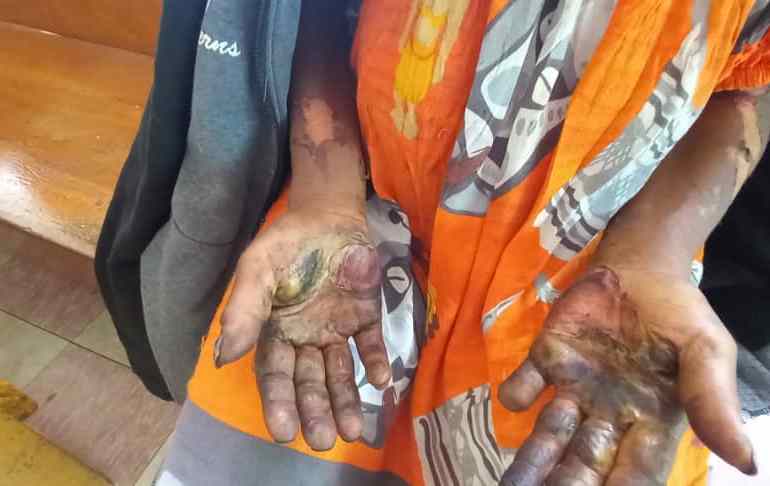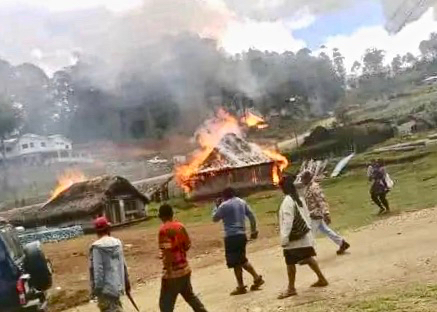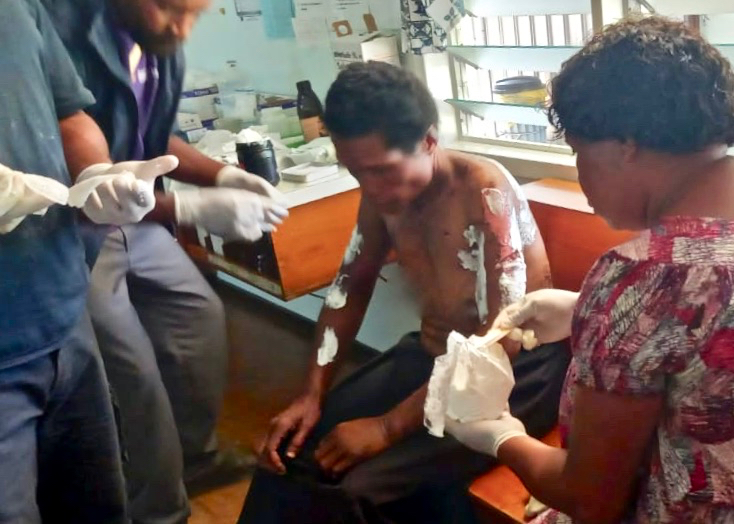PATRIARCHY; FEMICIDE, MYSOGYNY
Papua New Guinea fails to end ‘evil’ of sorcery-related violence
Brutal torture and assault of women accused of witchcraft go unpunished while initiatives to end crime make little progress.

Papua New Guinea continues to see cases of women accused of sorcery
and subjected to brutal torture
[Courtesy of Dickson Tanda]
By Ian Neubauer
Published On 16 Aug 2022
Reports of machete-wielding men slashing innocent bystanders, arson attacks, sexual violence against girls, and the displacement of thousands of people during last month’s election in Papua New Guinea have drawn international condemnation.
But an even more insidious form of violence continues to plague the country: sorcery-accusation-related violence (SARV), the public torture and murder of women accused of witchcraft.
The most recent high-profile case followed the unexplained death, most probably from a heart attack or stroke, of trucking magnate Jacob Luke while bushwalking in Enga, a rugged, poorly-developed province in the highlands of Papua New Guinea, whose body was discovered by telecommunication workers on July 21.
The following morning, members of Luke’s tribe at Lakolam village in Enga Province singled out nine women, including two in their sixties and one who was pregnant, and accused them of ‘kaikai lewa’ – secretly removing the victim’s heart and eating it to gain their virility.
After one of the women admitted to the allegation because she was so scared, the group was splashed with petrol and burned.
Five of the women were then singled out for torture which consisted of being tied naked between two poles and assaulted vaginally with hot irons while being watched by a mostly male crowd that also included some children and members of the victims’ families.
When news of the torture spread through the province, six police officers and a layman representative of the Catholic Church travelled to Lakolam village to rescue the women. But after a tense standoff involving hundreds of angry armed villagers convinced beyond doubt of the women’s guilt, police backed off.
A second attempt the following day also failed, but police later managed to rescue five of the women. The others had already died.
“They were tortured from Friday morning until midnight and lost a lot of body tissue and blood, so only five of them survived. They were giving off a bad smell from their wounds when we met them,” Dickson Tanda, the Catholic Church’s SARV coordinator in Enga, told Al Jazeera.
Dickson, who has helped rescue more than 600 women and children accused of sorcery since 2015, says witch-hunting in the province is becoming more barbaric and more frequent. “That rescue was last weekend,” he said on August 2. “This weekend just past we rescued another woman accused of sorcery. They tortured her, cut her with a machete all over her body and burned her skin off.”
Horrifying trends
Research from the Australian National University (ANU) published in 2020 found the attention on witchcraft and the torture and killing of women alleged to be involved in sorcery was “not only warranted but also urgent considering the apparent increase in number and the brutality with which the witch hunters operate”.
In a paper published a year earlier, the same authors found it was “very clear it is entering new geographical areas” like Enga, where they had found no records of such attacks taking place before 2010
.

After torturing those accused of sorcery, the perpetrators burn down the homes and evict them from the village [Courtesy of Dickson Tanda]
Enga Province police chief George Kakas agrees.
“In the past, the violence here was culturally oriented. We fought over land and property, pigs and women” he told Al Jazeera. “But now it is changing in the modern era. We see trends like robberies, rape and accusations of sorcery because the youths are confused.”
Another clear pattern that has emerged is the impunity enjoyed by those who carry out SARV attacks on women.
An ANU study published in 2017 found just 91 out of 15,000 perpetrators had been imprisoned for their crimes.
A follow-up study published 12 months later found that in 2018 some 121 individuals were given harsh sentences for SARV violence in relation to six cases of wilful murder.
In all those cases, the victims were men.
The researchers concluded misogyny was a factor not just in SARV itself but in the response to the crimes.
“Notably the gender trend in these judgements we have observed earlier continues, in that all the victims of these cases were men, suggesting that cases involving male victims are more likely to proceed,” the authors concluded.
Kakas says the problem of impunity begins with police, who are poorly resourced and educated, but also because few witnesses are willing to take the risk of helping law enforcement when there is no form of witness protection in Papua New Guinea.
“In the most recent case, no arrests have been made. We went into the village looking for suspects, but they had decamped. We asked the leaders of the village to surrender them but as several of them are also implicated in the atrocities committed, they did not cooperate. And we have no evidence because not a single person in the village is willing to be an eyewitness to the torture and murders as they fear for their own lives,” Kakas said.
“Another problem is many policemen don’t take these events too seriously. I remember one case where I sent two officers to arrest some people involved in torture and instead they started interrogating the victims, pressuring them to confess they were sorcerers. I had them disciplined but they got off the charges,” he said.
Kakas says he can recall only one case in the past eight years where someone accused of a sorcery-related attack was successfully prosecuted and sentenced in his jurisdiction.
‘Just evil’
Various initiatives have been introduced to stamp out the violence, but none has been successful.
Enga Province police chief George Kakas agrees.
“In the past, the violence here was culturally oriented. We fought over land and property, pigs and women” he told Al Jazeera. “But now it is changing in the modern era. We see trends like robberies, rape and accusations of sorcery because the youths are confused.”
Another clear pattern that has emerged is the impunity enjoyed by those who carry out SARV attacks on women.
An ANU study published in 2017 found just 91 out of 15,000 perpetrators had been imprisoned for their crimes.
A follow-up study published 12 months later found that in 2018 some 121 individuals were given harsh sentences for SARV violence in relation to six cases of wilful murder.
In all those cases, the victims were men.
The researchers concluded misogyny was a factor not just in SARV itself but in the response to the crimes.
“Notably the gender trend in these judgements we have observed earlier continues, in that all the victims of these cases were men, suggesting that cases involving male victims are more likely to proceed,” the authors concluded.
Kakas says the problem of impunity begins with police, who are poorly resourced and educated, but also because few witnesses are willing to take the risk of helping law enforcement when there is no form of witness protection in Papua New Guinea.
“In the most recent case, no arrests have been made. We went into the village looking for suspects, but they had decamped. We asked the leaders of the village to surrender them but as several of them are also implicated in the atrocities committed, they did not cooperate. And we have no evidence because not a single person in the village is willing to be an eyewitness to the torture and murders as they fear for their own lives,” Kakas said.
“Another problem is many policemen don’t take these events too seriously. I remember one case where I sent two officers to arrest some people involved in torture and instead they started interrogating the victims, pressuring them to confess they were sorcerers. I had them disciplined but they got off the charges,” he said.
Kakas says he can recall only one case in the past eight years where someone accused of a sorcery-related attack was successfully prosecuted and sentenced in his jurisdiction.
‘Just evil’
Various initiatives have been introduced to stamp out the violence, but none has been successful.

A victim of SARV is treated for their wounds [Courtesy of Dickson Tanda]
In 2015, the government announced the Sorcery National Action Plan (SNAP), a holistic initiative focusing on counselling, awareness, health advocacy, protection and research, but which had no solid targets.
Then there was Inap Nau! (Enough Now!), a 2018 campaign by Oxfam that looked at the problem from a gender-based perspective. Some 70 percent of women in Papua New Guinea experience rape or assault in their lifetime.
The Prime Minister’s Office in Papua New Guinea did not respond to Al Jazeera’s enquiries about the apparent failure of SNAP, while Oxfam PNG said it did not have time to respond to questions about Inap Nau! at “short notice”.
Kakas, who set up an anti-sorcery unit in 2016 within the police force to carry out awareness programmes and arrest offenders, says he knows why the initiatives did not work.
“Whenever there is a big case like this one there is a public outcry and some money is put into tackling the problem,” he said. “But when the hype fades, the funding disappears.”
A Catholic priest with the missionary Society of the Divine Word and a Professor of Social Research at Divine Word University in Papua New Guinea, Philip Gibbs, corroborates the claim.
“The government was supposed to fund the Sorcery National Action Plan, but that never happened,” Gibbs was reported as saying by The National newspaper in the capital Port Moresby last week.
Anton Lutz, an activist in sorcery-related crimes who has rescued several women and children from torture, accuses church groups of seeding the violence.
About 96 percent of people in Papua New Guinea identify as Christians, according to government statistics, while many combine their Christian faith with traditional Indigenous beliefs like animism and sorcery.
“The Catholic Church is one of the few actively fighting it. They have strong leaders who have excommunicated individuals and entire congregations that have aided and abetted torture, and they run some safe houses for survivors,” he told Al Jazeera.
“Other church denominations are neutral while others are complicit with preachers who actually advocate the violence. Many Christians are told that demons are real and that it is therefore plausible that there are evil people in the community who do Satan’s bidding. I think it goes back to their theology, where they believe in incarnate spiritual evil, which makes it hard to take a stance against witch-hunting because they could be accused of defending witches.”
Tanda, who in addition to rescuing women runs a privately-funded safe house for victims, is beyond trying to figure out the causes of sorcery-accusation-related violence or why it continues to be tolerated in Papua New Guinea.
“I don’t know. [The perpetrators] are just evil,” he said.
In 2015, the government announced the Sorcery National Action Plan (SNAP), a holistic initiative focusing on counselling, awareness, health advocacy, protection and research, but which had no solid targets.
Then there was Inap Nau! (Enough Now!), a 2018 campaign by Oxfam that looked at the problem from a gender-based perspective. Some 70 percent of women in Papua New Guinea experience rape or assault in their lifetime.
The Prime Minister’s Office in Papua New Guinea did not respond to Al Jazeera’s enquiries about the apparent failure of SNAP, while Oxfam PNG said it did not have time to respond to questions about Inap Nau! at “short notice”.
Kakas, who set up an anti-sorcery unit in 2016 within the police force to carry out awareness programmes and arrest offenders, says he knows why the initiatives did not work.
“Whenever there is a big case like this one there is a public outcry and some money is put into tackling the problem,” he said. “But when the hype fades, the funding disappears.”
A Catholic priest with the missionary Society of the Divine Word and a Professor of Social Research at Divine Word University in Papua New Guinea, Philip Gibbs, corroborates the claim.
“The government was supposed to fund the Sorcery National Action Plan, but that never happened,” Gibbs was reported as saying by The National newspaper in the capital Port Moresby last week.
Anton Lutz, an activist in sorcery-related crimes who has rescued several women and children from torture, accuses church groups of seeding the violence.
About 96 percent of people in Papua New Guinea identify as Christians, according to government statistics, while many combine their Christian faith with traditional Indigenous beliefs like animism and sorcery.
“The Catholic Church is one of the few actively fighting it. They have strong leaders who have excommunicated individuals and entire congregations that have aided and abetted torture, and they run some safe houses for survivors,” he told Al Jazeera.
“Other church denominations are neutral while others are complicit with preachers who actually advocate the violence. Many Christians are told that demons are real and that it is therefore plausible that there are evil people in the community who do Satan’s bidding. I think it goes back to their theology, where they believe in incarnate spiritual evil, which makes it hard to take a stance against witch-hunting because they could be accused of defending witches.”
Tanda, who in addition to rescuing women runs a privately-funded safe house for victims, is beyond trying to figure out the causes of sorcery-accusation-related violence or why it continues to be tolerated in Papua New Guinea.
“I don’t know. [The perpetrators] are just evil,” he said.
SOURCE: AL JAZEERA
No comments:
Post a Comment